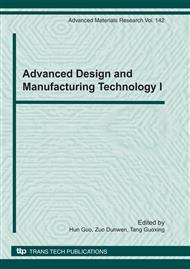p.103
p.107
p.112
p.117
p.122
p.126
p.130
p.134
p.139
Numerical Simulation of the Machining Distortion of Aircraft Aluminum Part Caused by Redistribution of Residual Stress
Abstract:
In order to reduce the weight of airplane and increase its mechanical behaviors, more and larger integrated parts are applied in modern aviation industry. When machining multi-frame aeroplane parts, more than 90% of the materials would be removed, resulting in severe distortion of the parts due to the weakened rigidity and the release of residual stress. This might also lead to stress concentration and damage of the parts. The effect of material removal from residually stressed billet is simulated using FEA software ANSYS, and the causations of distortion is analyzed. To verify the finite element simulation, a high speed milling test on aluminum alloy 7050T7351 is carried out. The results show that the simulation result is consistent with the experimental one. It included that the original residual stress in the blocks of aero-aluminum component is one of key factors to cause machining distortion.
Info:
Periodical:
Pages:
122-125
Citation:
Online since:
October 2010
Authors:
Keywords:
Price:
Сopyright:
© 2011 Trans Tech Publications Ltd. All Rights Reserved
Share:
Citation:


